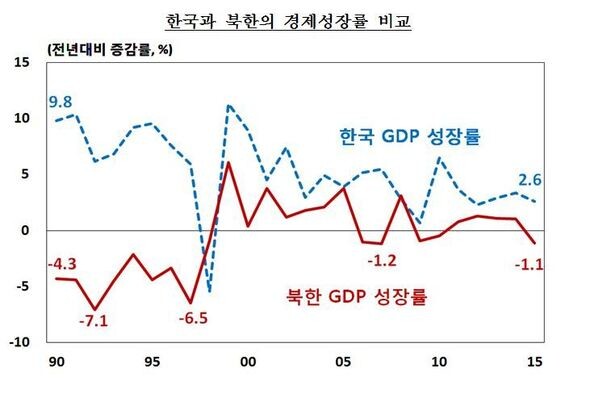hankyoreh
Links to other country sites 다른 나라 사이트 링크
North Korea has negative economy growth for first time in five years

The North Korean economy experienced negative growth for the first time in five years, reaching its lowest level since 2007, recent estimates show.
The gap in economic power between South and North Korea also widened further, with the difference in per capita income growing from 21.4 times in 2014 to 22.2 times last year.
Estimates of the 2015 North Korean economic growth rate released by the Bank of Korea (BOK) on July 22 showed a real gross domestic product (GDP) growth rate of 1.1% for last year. It was the lowest level since 2007, when the rate was tallied at -1.2%. North Korea last experienced a negative rate of economic growth in 2010, when the rate was -0.5%.
The North Korean farming, forestry, and fishing sectors experienced a drop of 0.8% from the year before (1.2%), with large increases in livestock farming and fishing offset by declining yields for rice, corn, and other grains. Mining was down 2.6% amid falling iron ore and magnesite production, while manufacturing dropped by 3.4% with slack production in both light industries and heavy and chemical industries. The findings also showed a steep 12.7% decline in the electricity, gas, and water industry.
“Production of steel, machinery, and other items experienced negative effects from a decline in North Korea’s hydroelectric power owing to drought conditions last year,” explained the BOK.
At the same time, construction was up 4.8% amid rises in both building construction and public works, while services rose 0.8%, mainly in the areas of government services, wholesale and retail sales, and communications.
North Korea’s nominal gross national income (GNI) for last year was estimated at 34.5 trillion won (US$30.4 billion), an increase of 300 billion won (US$264 million), or 0.8%, from the year before. The result was a widening gap with the South Korean economy, with the North’s economy falling to 1/45 the South’s economy of 1.5658 quadrillion won (US$1.38 trillion) from 1/43.5 the previous year. The gap also grew in terms of per capita GNI, with North Korea’s level of 1,393,000 won (US$1,226) rising slightly from 1,388,000 won (US$1,221) in 2015 but falling to 1/22.2 the South’s level of 30,935,000 won (US$27,221), down from 1/21.4 the year before.
North Korea’s foreign trade with countries other than South Korea totaled US$6.25 billion, down 17.9% from US$7.61 billion in 2014. Exports also fell 14.8% from the year before to US$2.7 billion, while imports dropped by 20.2% to US$3.56 billion. At US$2.71 billion, inter-Korean trade rose 15.7% from 2014.
Exports from South to North rose 19.8%, chiefly in the form of electronics and chemical industry products. Imports from North to South jumped by 20.4% with major rises in most areas, including electronics and daily items. Analysts interpreted the gains as coming from trade through the Kaesong Industrial Complex, which was closed in February.
By Yu Sun-hui, staff reporter
Please direct questions or comments to [english@hani.co.kr]

Editorial・opinion
![[Column] Has Korea, too, crossed the Rubicon on China? [Column] Has Korea, too, crossed the Rubicon on China?](https://flexible.img.hani.co.kr/flexible/normal/500/300/imgdb/original/2024/0419/9317135153409185.jpg) [Column] Has Korea, too, crossed the Rubicon on China?
[Column] Has Korea, too, crossed the Rubicon on China?![[Correspondent’s column] In Japan’s alliance with US, echoes of its past alliances with UK [Correspondent’s column] In Japan’s alliance with US, echoes of its past alliances with UK](https://flexible.img.hani.co.kr/flexible/normal/500/300/imgdb/original/2024/0419/2317135166563519.jpg) [Correspondent’s column] In Japan’s alliance with US, echoes of its past alliances with UK
[Correspondent’s column] In Japan’s alliance with US, echoes of its past alliances with UK- [Editorial] Does Yoon think the Korean public is wrong?
- [Editorial] As it bolsters its alliance with US, Japan must be accountable for past
- [Guest essay] Amending the Constitution is Yoon’s key to leaving office in public’s good graces
- [Editorial] 10 years on, lessons of Sewol tragedy must never be forgotten
- [Column] A death blow to Korea’s prosecutor politics
- [Correspondent’s column] The US and the end of Japanese pacifism
- [Guest essay] How Korea turned its trainee doctors into monsters
- [Guest essay] As someone who helped forge Seoul-Moscow ties, their status today troubles me
Most viewed articles
- 1[Column] The clock is ticking for Korea’s first lady
- 2After 2 months of delayed, denied medical care, Koreans worry worst may be yet to come
- 3Hong Se-hwa, voice for tolerance whose memoir of exile touched a chord, dies at 76
- 4Samsung barricades office as unionized workers strike for better conditions
- 5[Column] Has Korea, too, crossed the Rubicon on China?
- 6US overtakes China as Korea’s top export market, prompting trade sanction jitters
- 7[Editorial] As it bolsters its alliance with US, Japan must be accountable for past
- 8[Correspondent’s column] In Japan’s alliance with US, echoes of its past alliances with UK
- 9All eyes on Xiaomi after it pulls off EV that Apple couldn’t
- 10[Guest essay] How Korea turned its trainee doctors into monsters